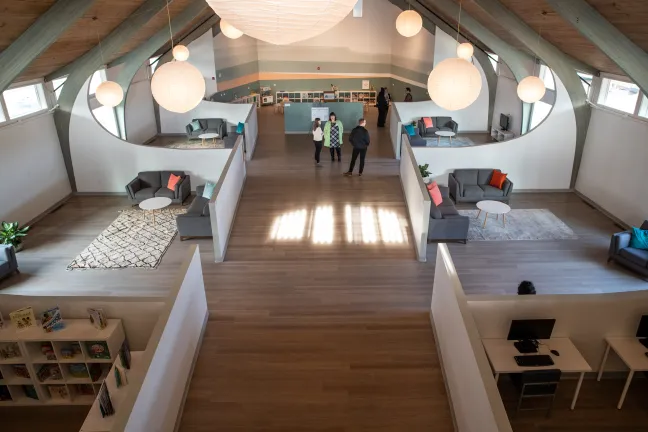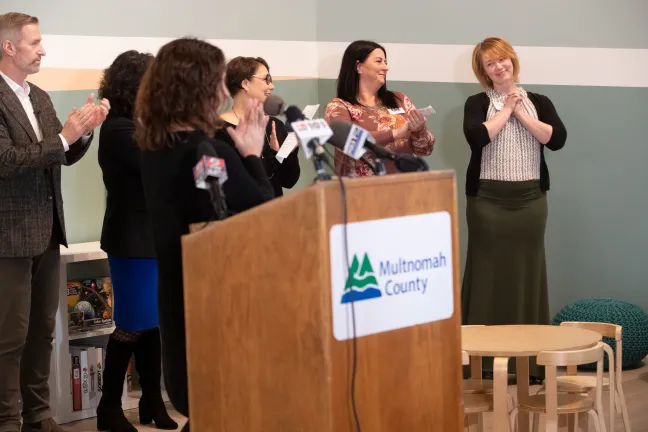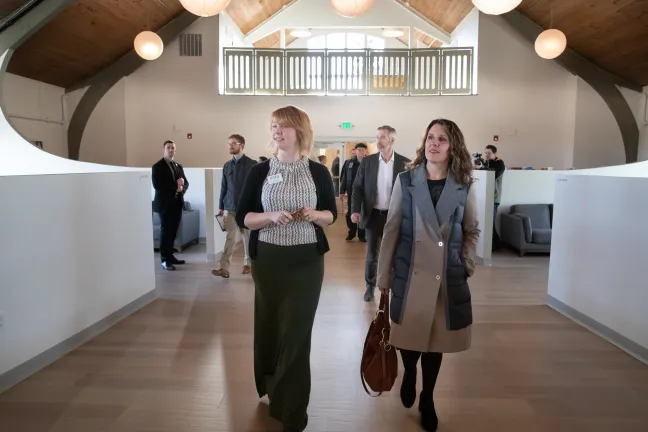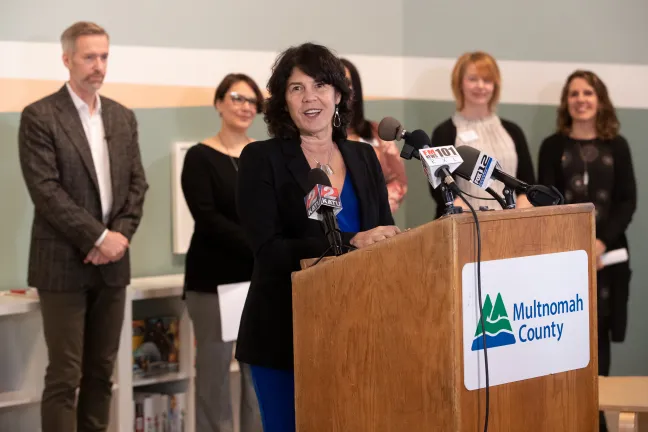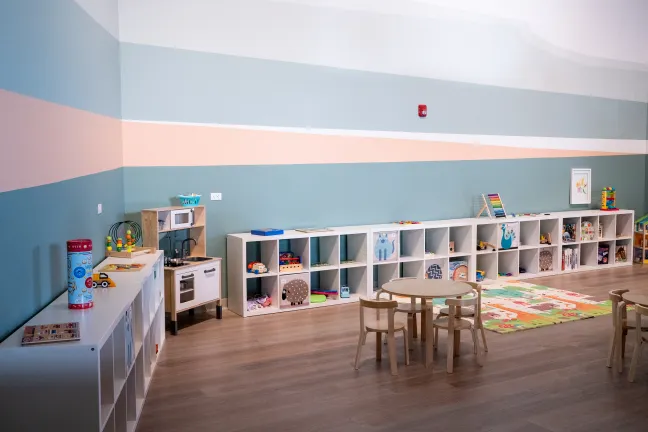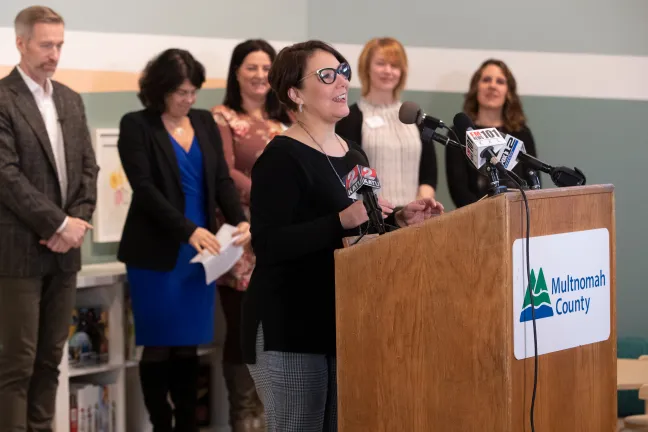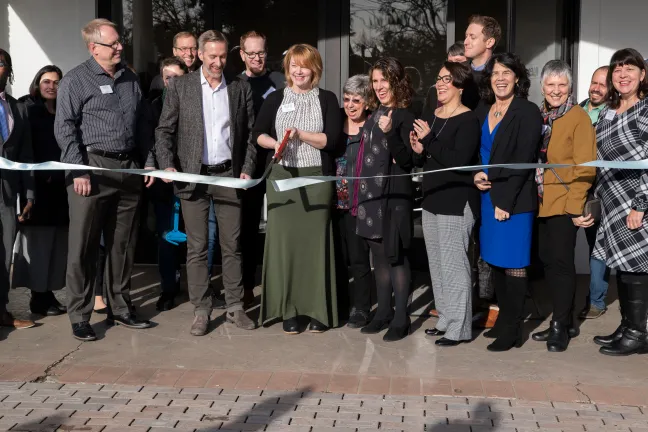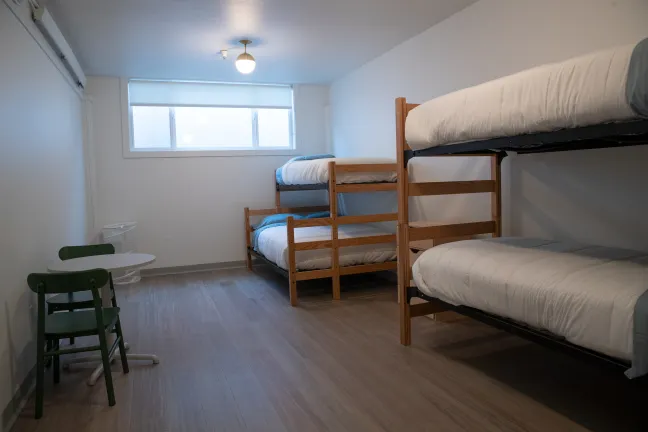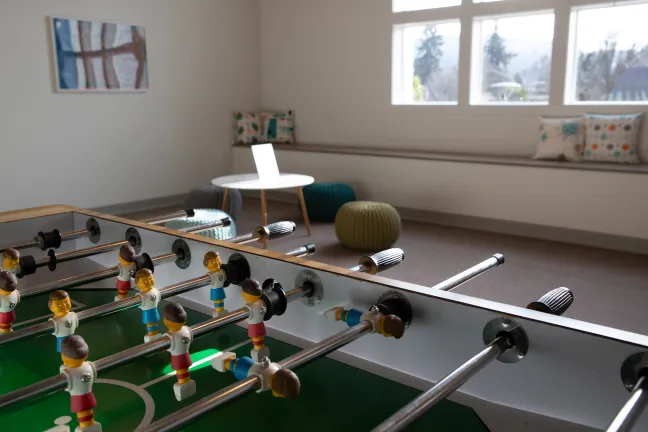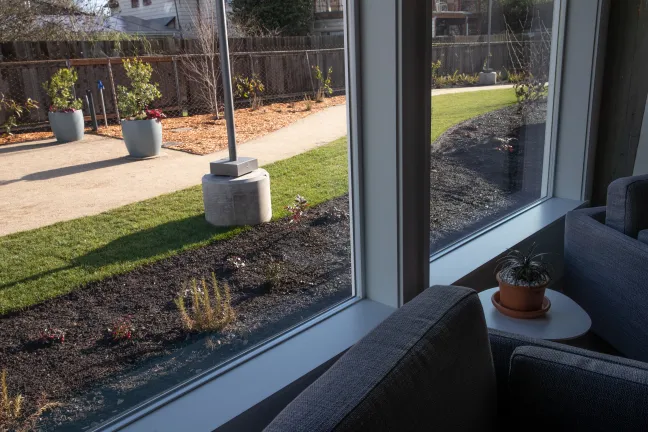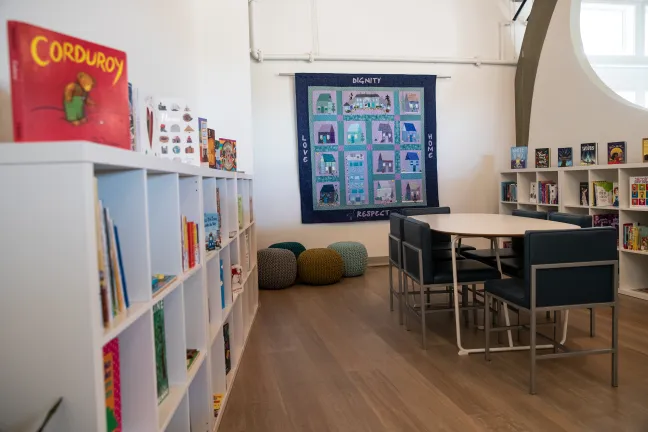The transformation of Multnomah County’s family shelter system into one with personal rooms and onsite services reached completion Monday, Dec. 16, after Portland Homeless Family Solutions opened its Family Village campus in Lents.
Once it reaches full capacity, the spacious and trauma-informed Family Village will offer personal rooms with round-the-clock safety to as many as 25 families (nearly 100 kids and parents) — more than three times the number of families served before the new space opened.
Beyond shelter, families at the Village will also be able to access a variety of services including rapid rehousing, homelessness prevention, life skills classes, mental health care, a meal, or a pack of diapers.
Housing resources will also be tripled, said Brandi Tuck, Portland Homeless Family Solutions’ director, to ensure families move through shelter as quickly as possible and into homes of their own.
“We believe housing is the solution to homelessness,” she said.
Tuck said the state of Oregon counted 4,000 students experiencing homelessness in Multnomah County schools alone last year. That number, she notes, doesn’t include younger siblings and parents.
“These staggering numbers made PHFS realize we need to improve our programs to help more kids and parents without homes,” she said.
Shelter part of larger expansion of family capacity
Overall, thanks to two other publicly supported shelters in Multnomah County, for a total of three, the Joint Office of Homeless Services will be now able to serve 70 families in personal rooms on any given night. Depending on family size, that could add up to services for 200 to 300 people.
Just five years ago, the County had no year-round, 24-hour shelter beds for families. Now, every room funded through public dollars is open all day, all year. Human Solutions operates a 40-room shelter called Lilac Meadows in a renovated motel in Southeast Portland. Community of Hope, meanwhile, operates a recently renovated shelter for eight families in St. Johns.
“One of the unwritten promises we make to our children is that, as parents, we have it all under control, even when we might not. But being homeless changes all that,’’ Chair Deborah Kafoury said. “It strikes at the heart of that promise: shaking a kid’s confidence, and placing unimaginable stress on a parent.”
“We all tried to imagine what a better shelter system for families might look like,’’ she said “Well, it looks like this.”
In a first for the community, the Family Village will offer its services in a building centered on trauma-informed design principles. Portland Homeless Family Solutions worked with employees and families to think through details and color palettes that would work to build dignity and promote autonomy.
“Research shows that shelters with trauma-informed architecture and interior design can help people heal through the crisis of homelessness and lead to better outcomes,” Tuck said. “Trauma-informed design leads to people feeling empowered in control of their lives and hopeful for the future.”
City and Joint Office join hundreds of community contributions
Portland Homeless Family Solutions purchased the campus, formerly a church, for $3 million in 2018. They then devised a plan to renovate the property, which also includes apartments and land to build even more housing, with help from community donations. Preparing the former church to serve as a shelter cost an additional $2 million.
The City of Portland contributed $500,000 toward the purchase, while the Joint Office contributed $300,000 toward renovation costs, in addition to the funding it will contribute for operations. In total, Tuck said, some 1,000 individuals, businesses and nonprofits contributed to the project, which also won support from the Lents community.
“When I walk through the Family Village, I feel the love, positive energy and goodwill that radiates through this campus because of our community’s contributions,” Tuck said.
Mayor Ted Wheeler reflected on the time he spent some 20 years ago volunteering at the Family Village’s predecessor shelter in Goose Hollow, which was open only at night in a church basement.
“It was a formative experience to me and it opened my eyes,” he said. “It really taught me that people who are at the worst times of their lives are still willing to do anything.”
He said it was easy for the Portland City Council to contribute to the project, given what it would become.
“At a time when there’s such a lack of compassion for the most vulnerable people in our community, we’re building a house of love,” he said. “This facility could not be and would not be built just anywhere, unfortunately. There’s something unique about this community.
Commissioner Sharon Meieran also remembered the old Goose Hollow shelter from her time as a volunteer, and how different the intentionally designed Family Village makes people feel.
She said Portland Homeless Family Solutions “has modeled here what it looks like, what it actually feels like, not only to focus on what we do for families in shelter but how we do it and where we do it. Place and space truly matter.”
As an emergency room doctor, Meieran said, “I know that the physical environment directly impacts people’s mental, physical and social health. This space has made me feel better just by being here for the few minutes I’ve been here. The impact it will have on these families’ lives will be immeasurable.”
Changes to shelter come as housing remains scarce
The campus also speaks to the ongoing transformation of family shelter overall in Portland and Multnomah County.
For years, most family shelter beds were in large open rooms shared by dozens of people. Today, every family in shelter has space all to themselves.
That change has occurred in large part because of how families are experiencing homelessness. Because of the region’s housing crisis, the need for shelter is growing. On any given night, 56,000 households across the metro region teeter on the brink of homelessness, spending half of their limited incomes on housing costs.
And instead of staying in shelter for a few days or weeks, some families increasingly need those beds for months. To support healthy families, that meant bringing more services to shelters, and creating better spaces for kids to do homework, and for parents to rest, heal and hold down jobs.
If families can stay in spaces with dignity and privacy, but still find support and community, then they’ll be more likely to thrive in the housing they eventually find.
“If there would have been a place like Family Village when I needed shelter, I would have jumped at the chance,” said Angi Eagan, a single mom of three kids who once was homeless, but now works at Portland Homeless Family Solutions helping other families return to housing.
She said it takes time for families to take off the armor of survival and settle into a sense of security. “Having a place like Family Village to call home will create the ability for families to start the work toward healing the trauma of being homeless.”
Commissioner Jessica Vega Pederson, whose Southeast Portland district includes the shelter, said the region’s housing crisis — with one in three households spending half their income on rent — has disproportionately affected east Portland neighbors and the city’s communities of color.
And that’s why a shelter like the Family Village, in east Portland, “is so critical.”
“If people are losing their homes, they need as much stability as they can get,” she said. “Moving schools, finding new grocery stores, new commutes, new routines, new friends, new networks, all of those are difficult and stressful. Families struggling with houselessness don’t need more stressors. They need stability. They need peace and beauty. And this shelter can provide it.”
Chair Kafoury pointed out that housing is the next step for families who come into shelter — and that no shelter is good enough if there’s not a place to go once a family is stable and ready to leave.
“The next challenge for elected leaders is to make good on our promises. We must make sure that there are enough homes for families at the end of their journey from homelessness,” she said. “And to do that, we are going to need funding. A lot of it. But the good news is that we already know our entire community is ready to pitch in.”
“I know I am ready.”
